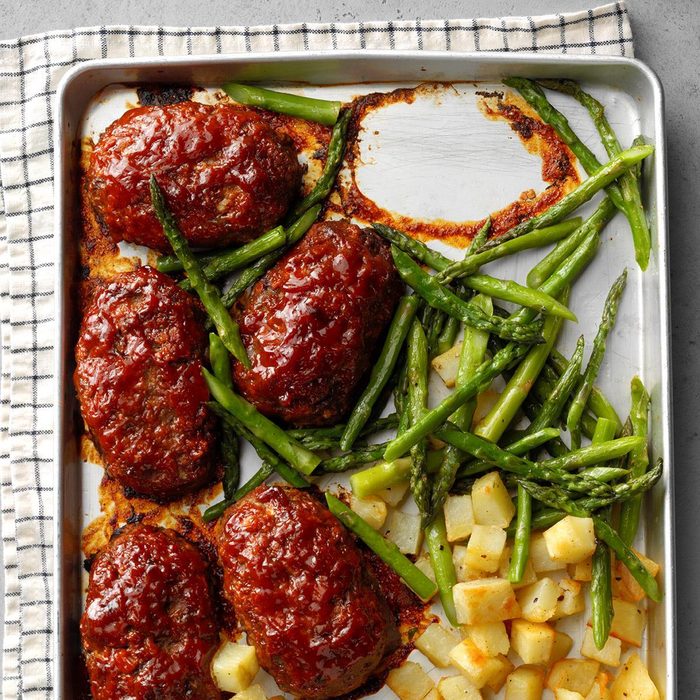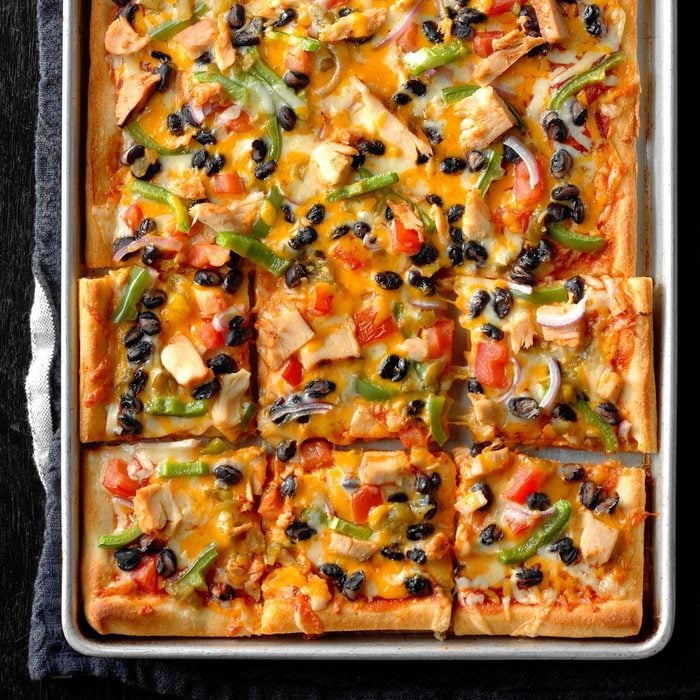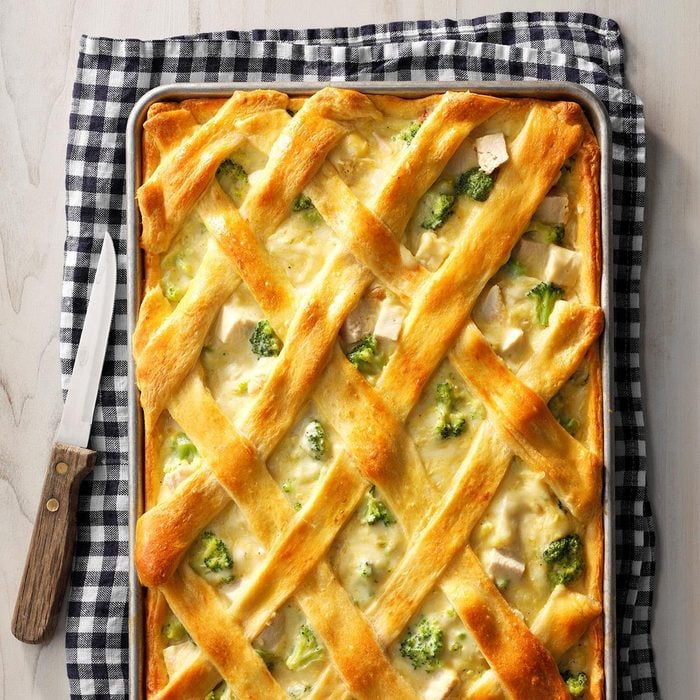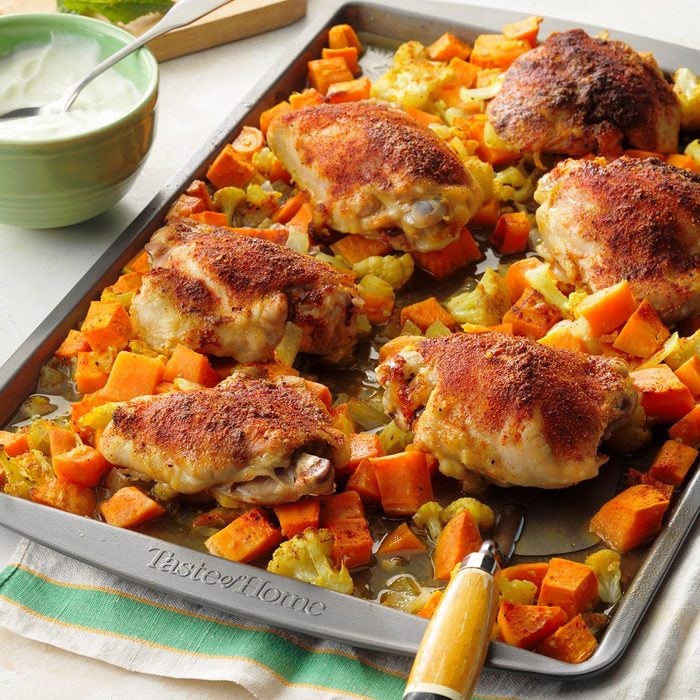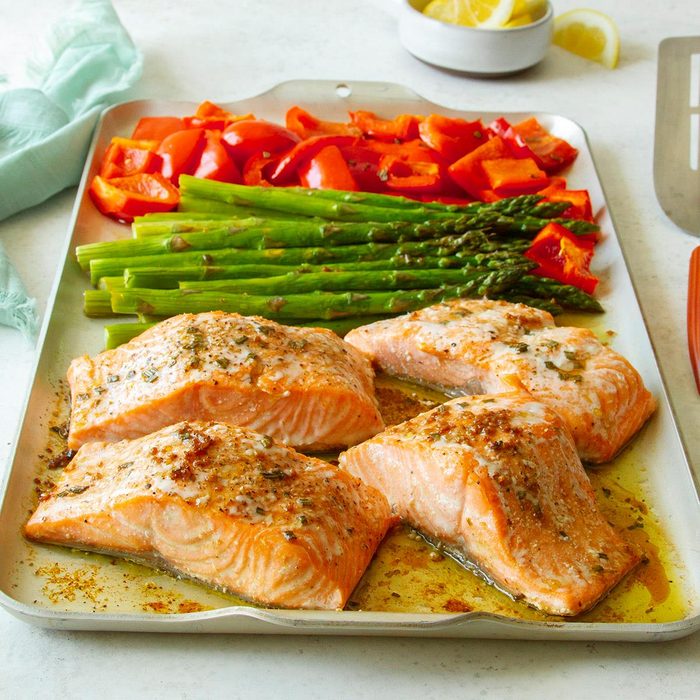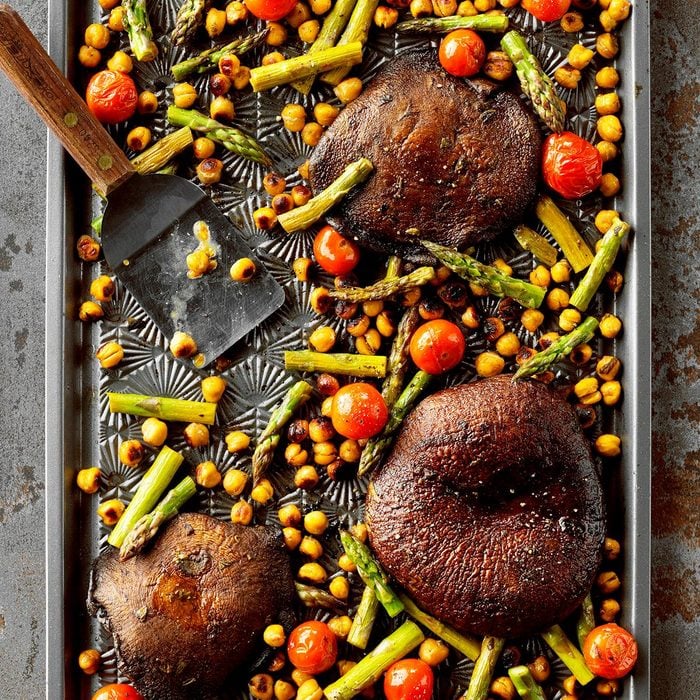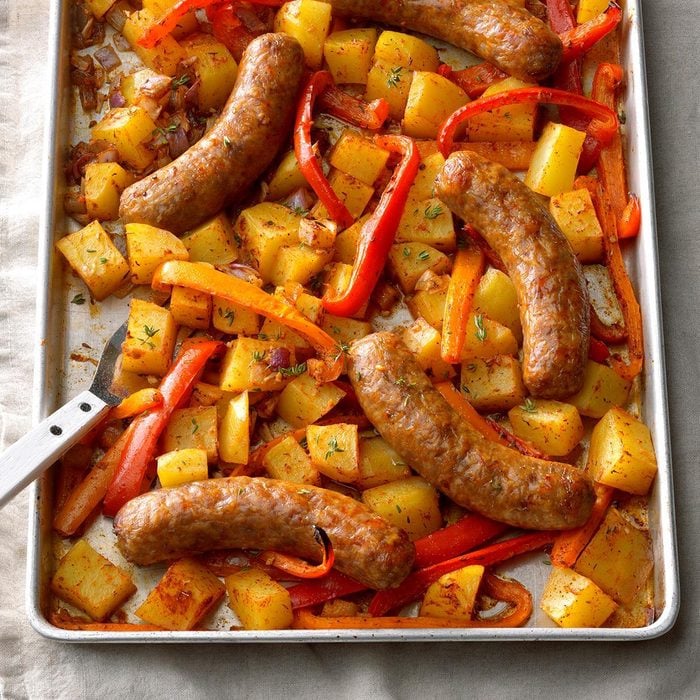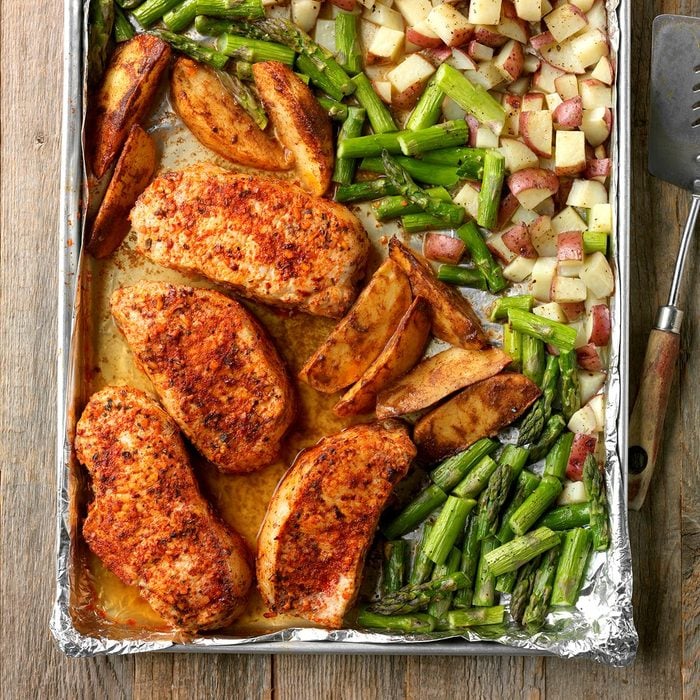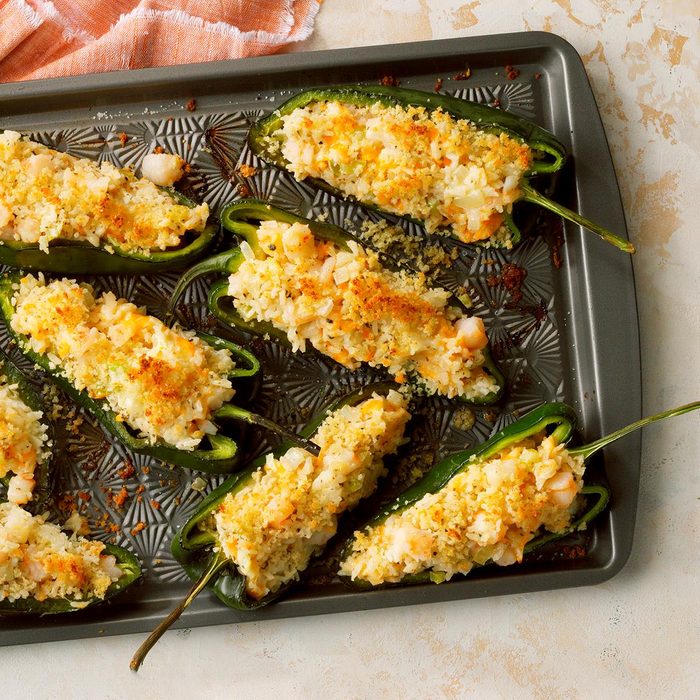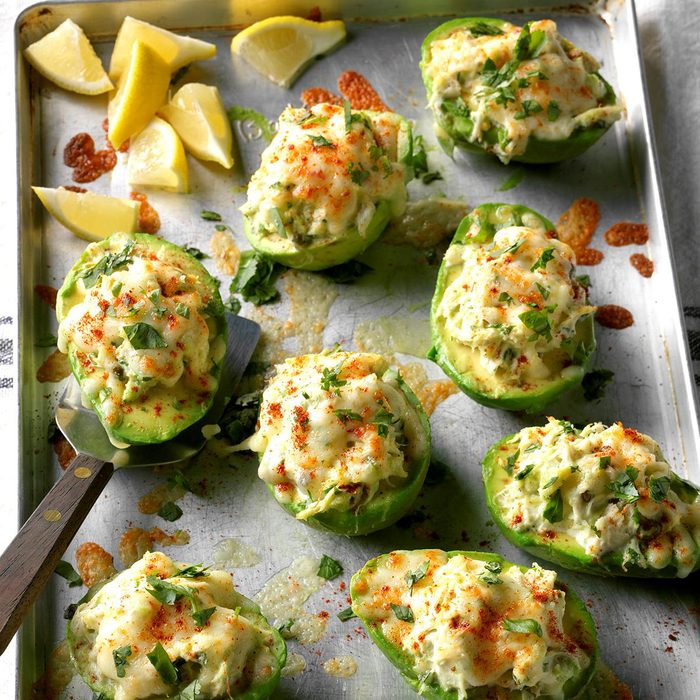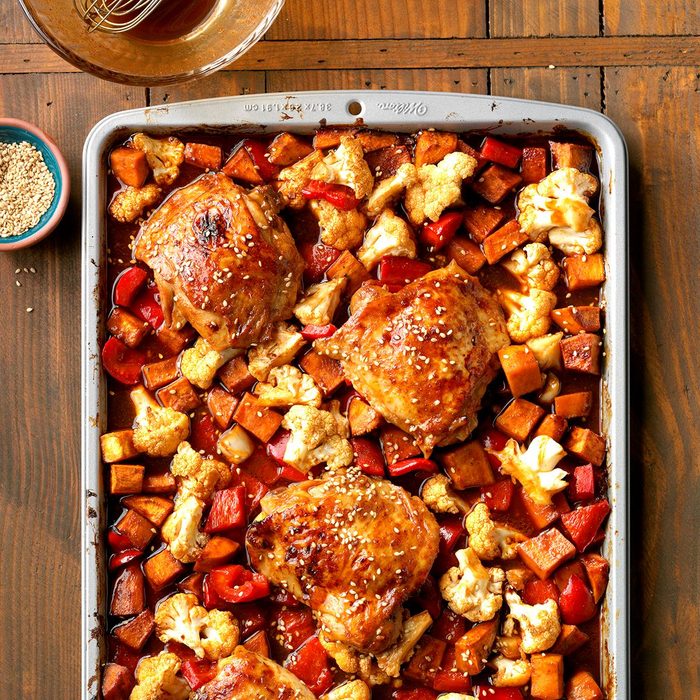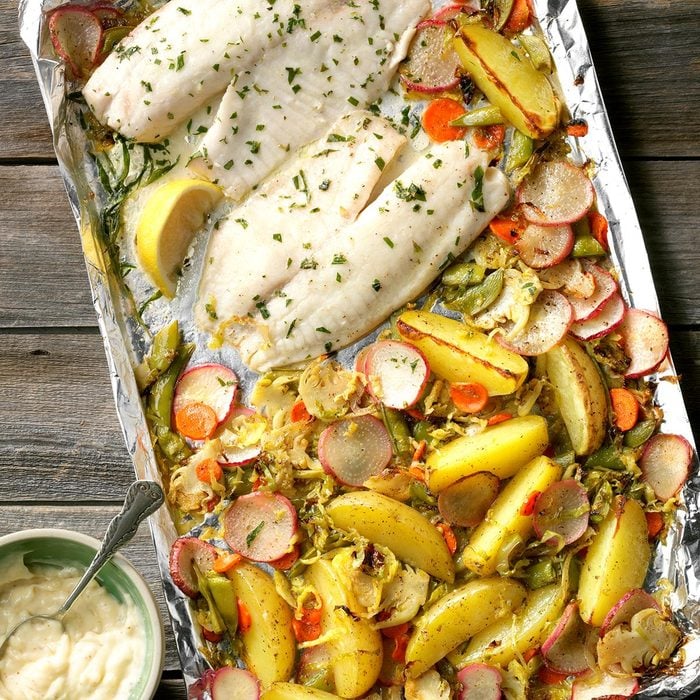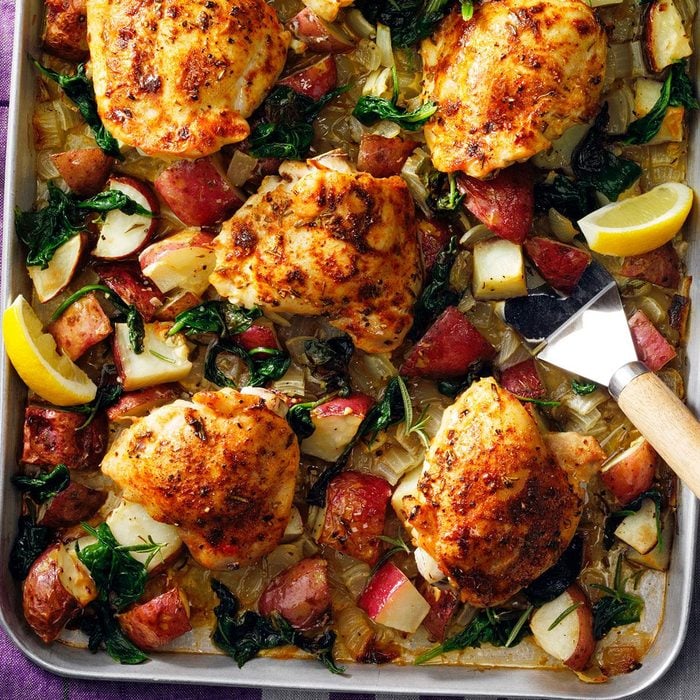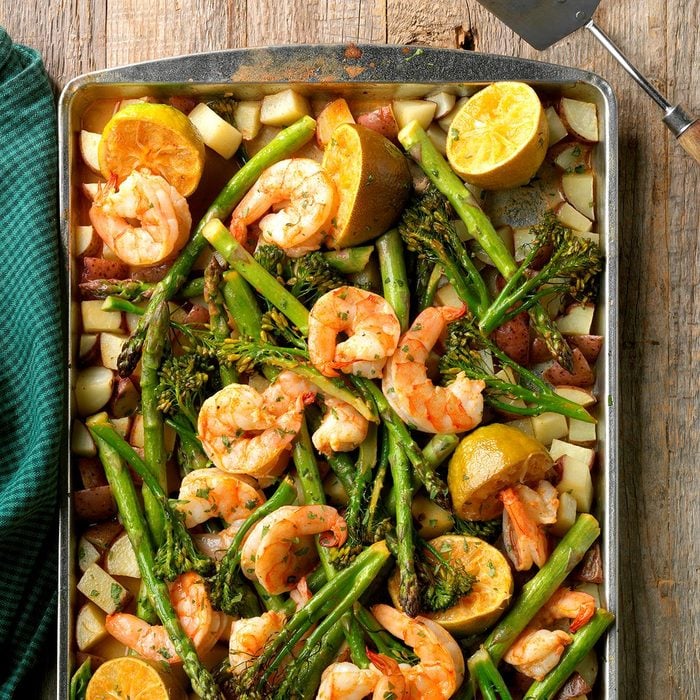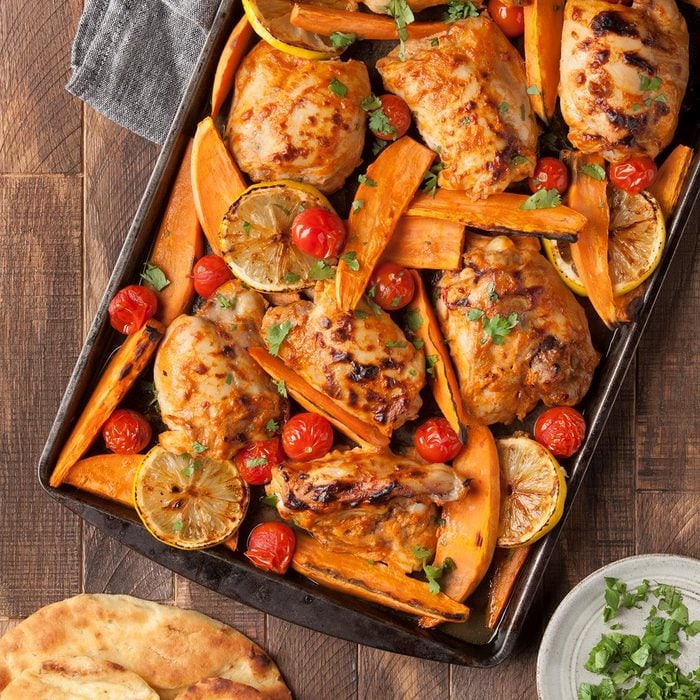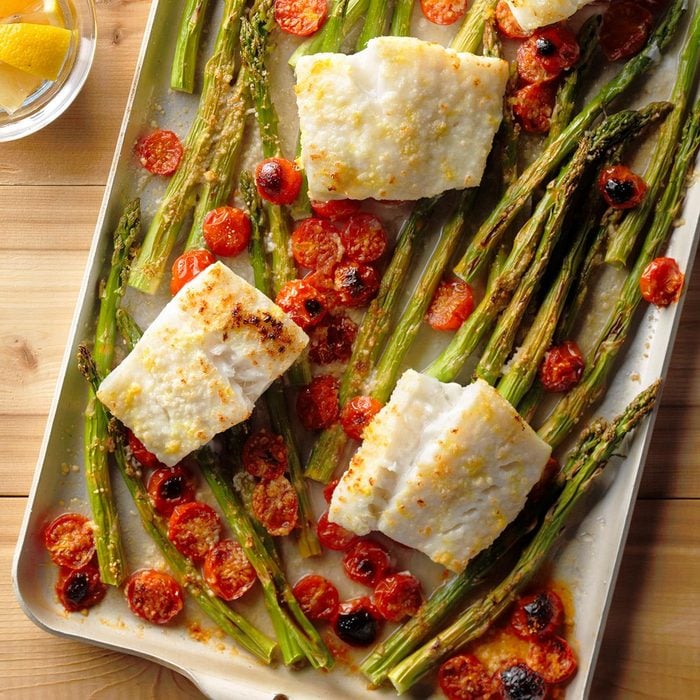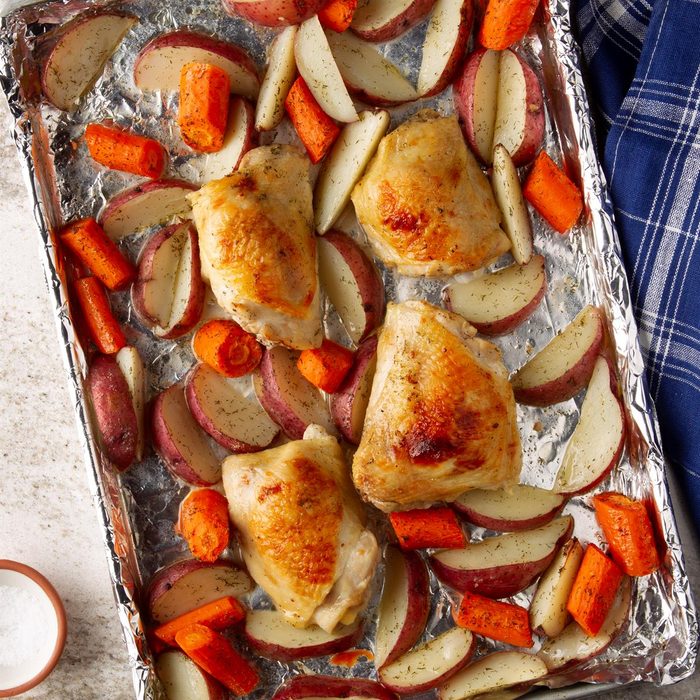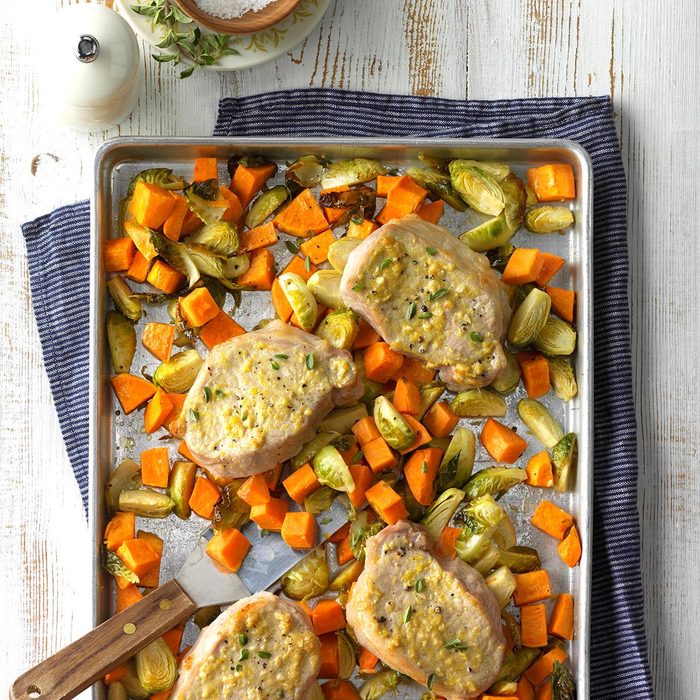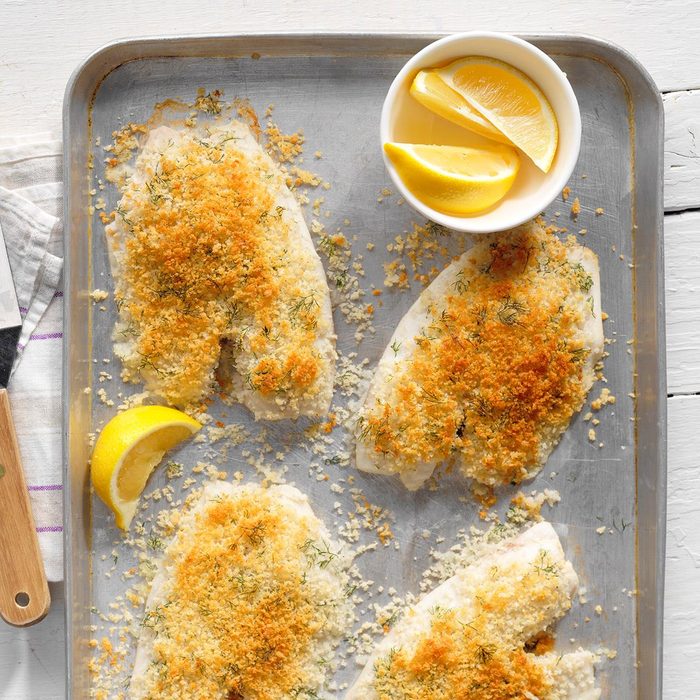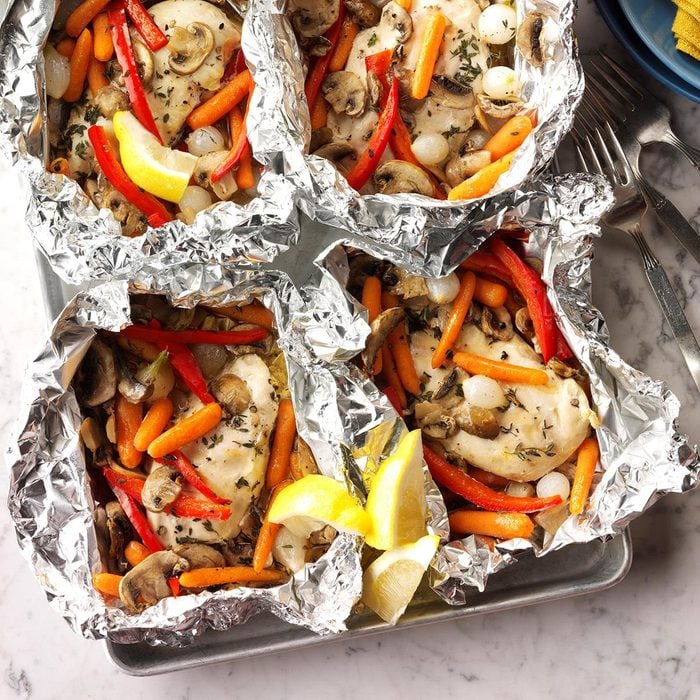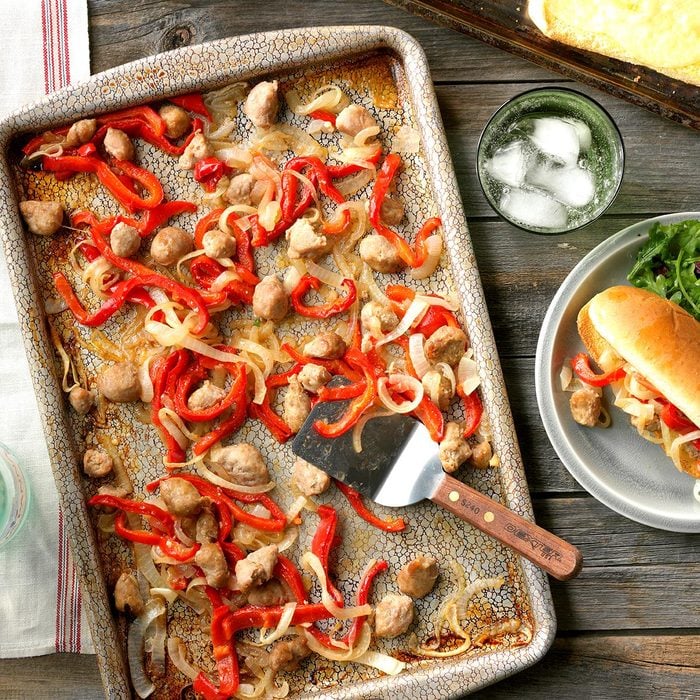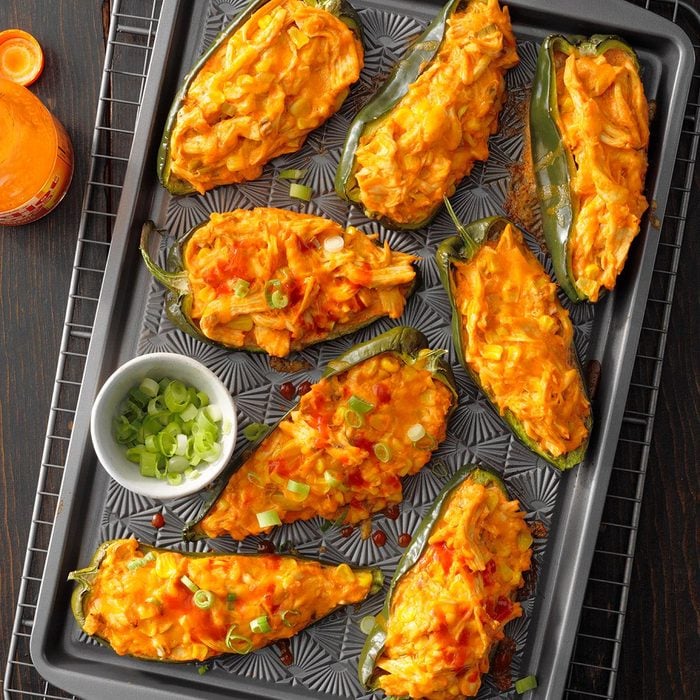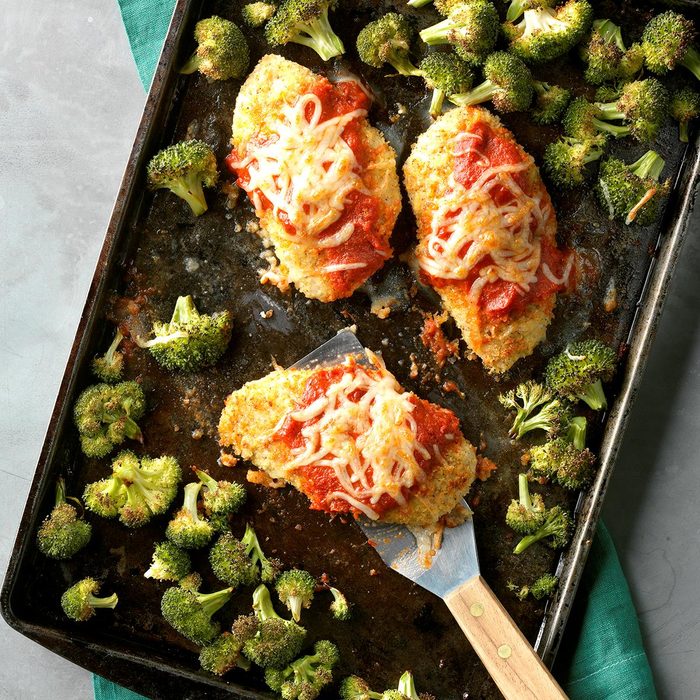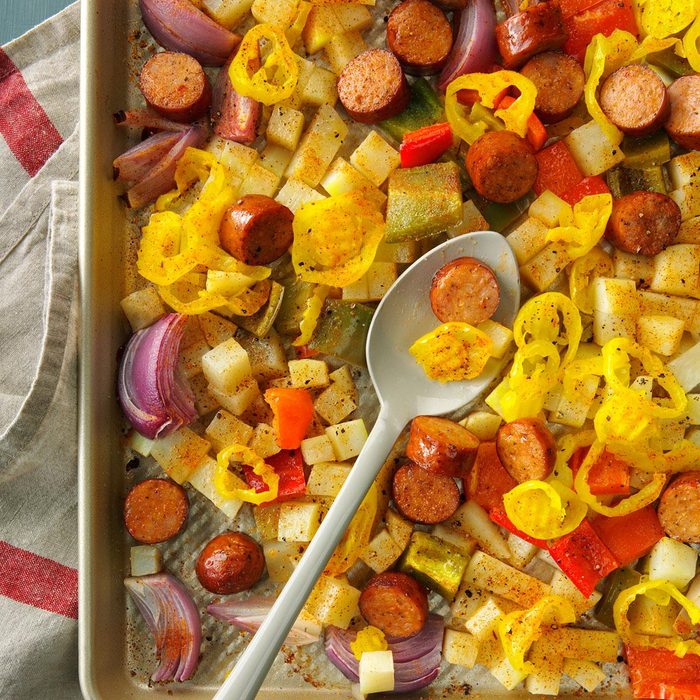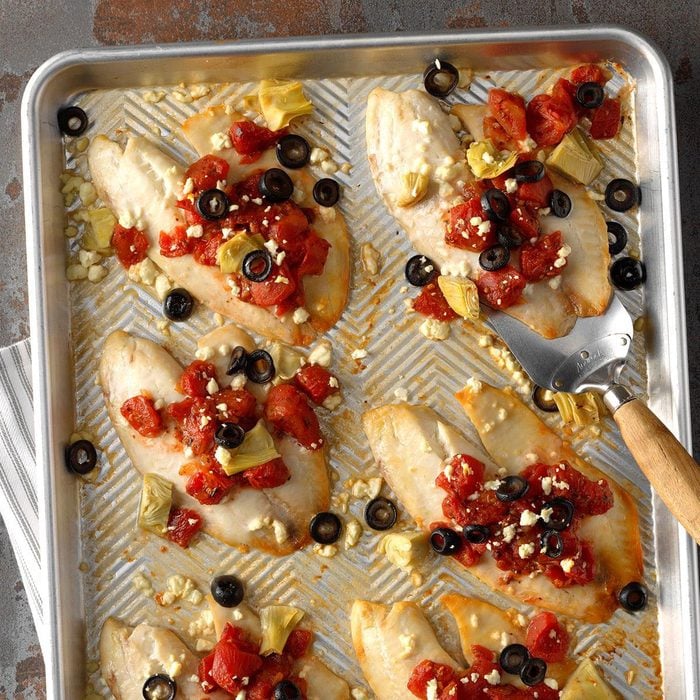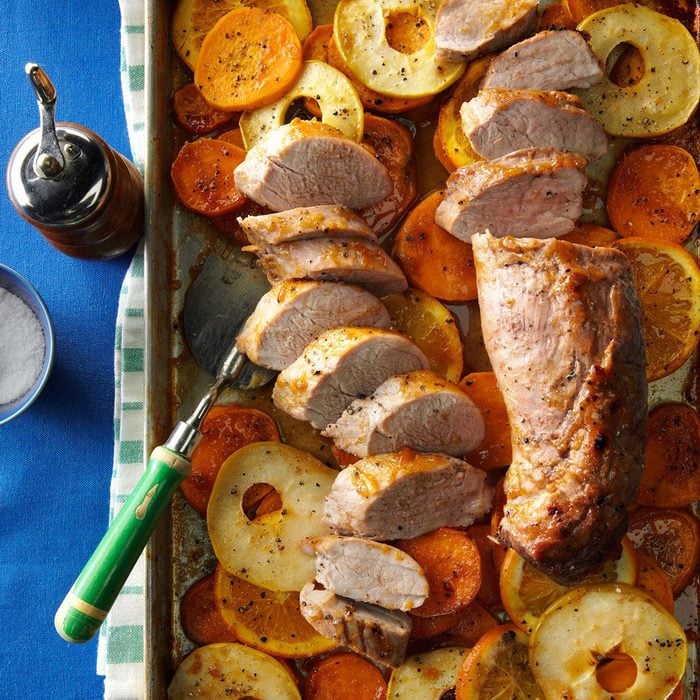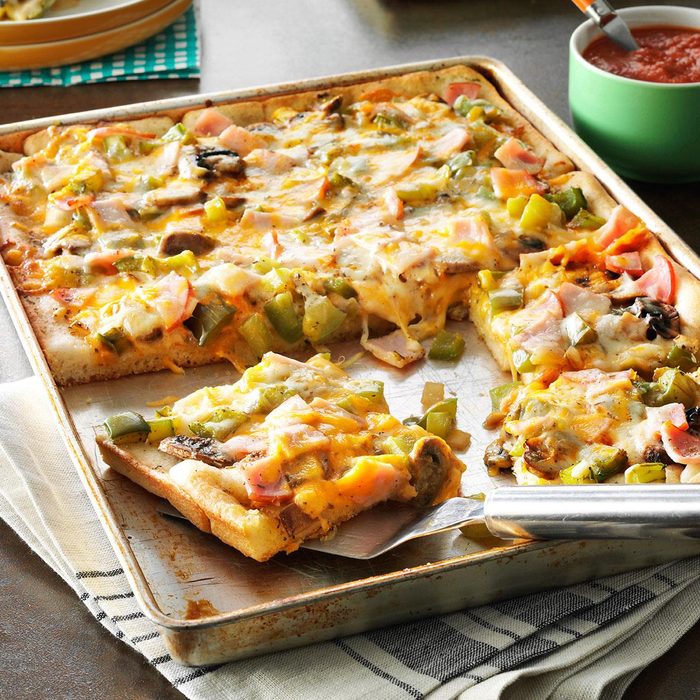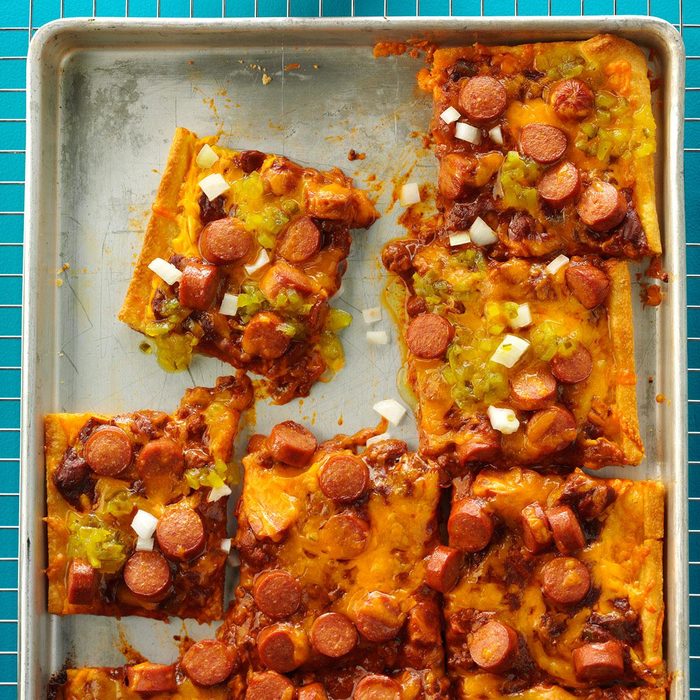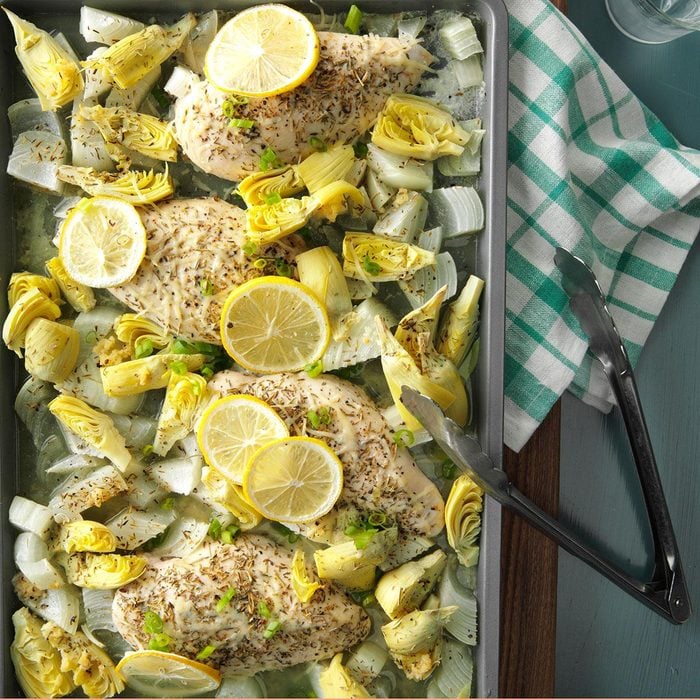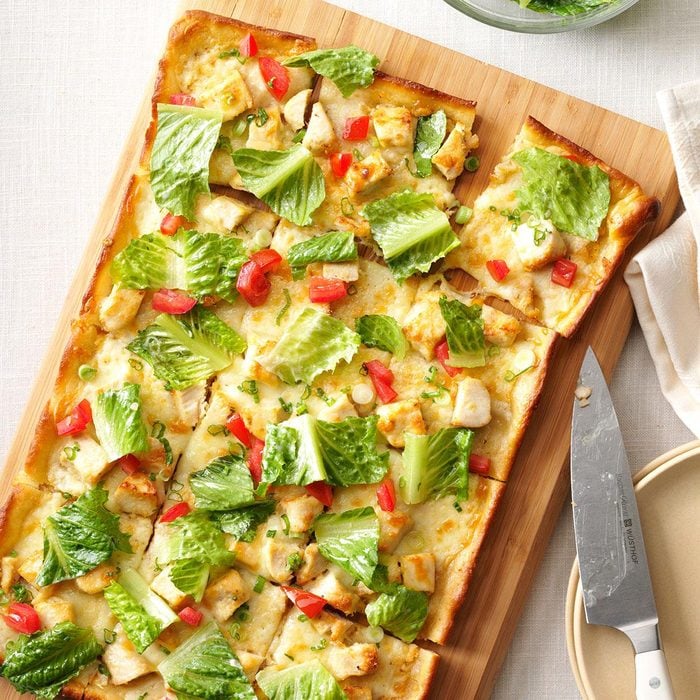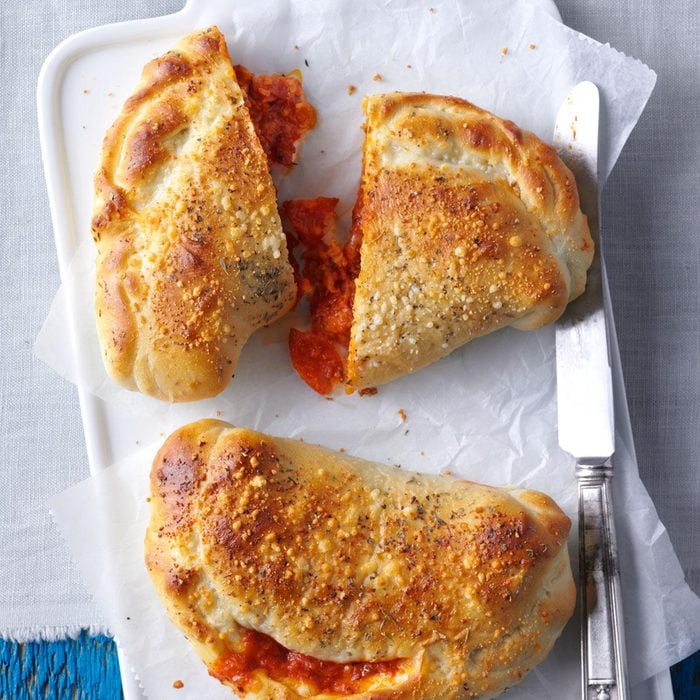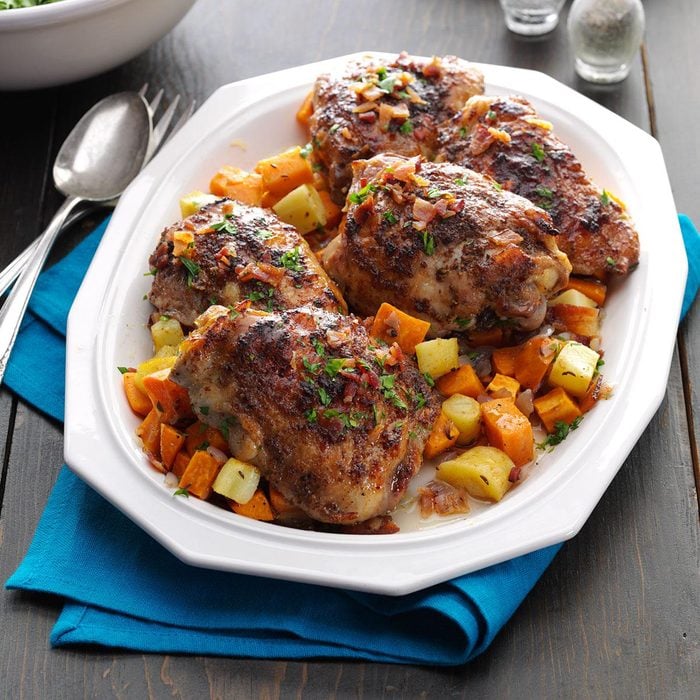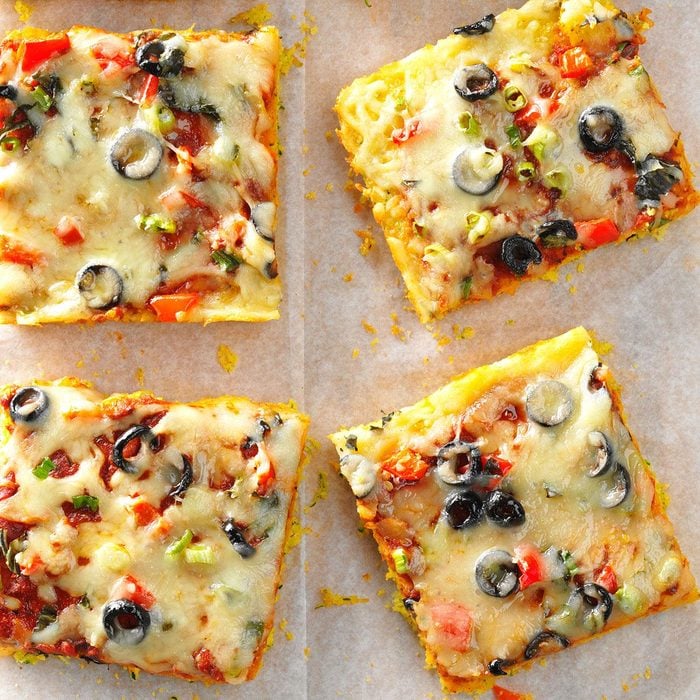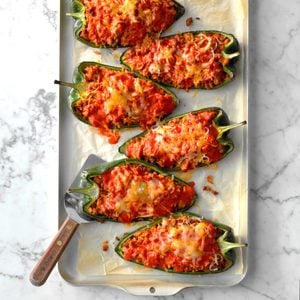 Taste of Home
Taste of Home
My partner adores these saucy stuffed peppers—and I love how quickly they come together. Top with low-fat sour cream and your favorite salsa. —Jean Erhardt, Portland, Oregon
Go to Recipe
Need an update? You can buy a Taste of Home nonstick sheet pan on Amazon!
Sheet-Pan Lemon Garlic ChickenEveryone needs an easy meal. Try this sheet-pan chicken with roasted potatoes for a simple and tasty meal guaranteed to please the whole family. If you use fresh lemon juice, garnish each serving with a little lemon zest for bright flavor. —Andrea Potischman, Menlo Park, California
Sheet-Pan Pork SupperI created this pork tenderloin sheet-pan dinner to suit our family's needs. It's so quick and easy to clean up since you use one pan for everything! Use any variety of small potatoes—fingerlings or other colored potatoes are a fun and delicious option. —Debbie Johnson, Centertown, Missouri
Mini Meat Loaf Sheet-Pan MealI grew up with this classic meat loaf recipe, but I adapted it to mini meatloaves so that they would bake more quickly. The sauce topping is always a hit. I added the potatoes and asparagus to make an easy complete meal. —Deanne Johnson, Reading, Pennsylvania
Santa Fe Chicken Pizza PieGive your pie a Southwest twist when you slather on the taco sauce and top with black beans, green chilies and kicked-up chicken strips. —Taste of Home Test Kitchen, Milwaukee, Wisconsin
Turkey Lattice PieWith its pretty lattice crust, this cheesy baked dish looks as good as it tastes. It's easy to make, too, since it uses ready-to-go crescent roll dough. —Lorraine Naig, Emmetsburg, Iowa
Sheet-Pan Chicken Curry DinnerThis sheet-pan chicken curry is a quick way to get a meal on the table without fuss. Everyone loves it, and it's healthy to boot! Serve it with a side of jasmine rice. —Trisha Kruse, Eagle, Idaho
Rosemary Salmon and VeggiesMy husband and I eat a lot of salmon. One night, while in a rush to get dinner on the table, I created this rosemary salmon meal. It's a keeper! You can also include sliced zucchini, small cauliflower florets or fresh green beans. —Elizabeth Bramkamp, Gig Harbor, Washington
Portobello and Chickpea Sheet-Pan SupperThis is a fantastic meatless dinner or an amazing side dish. It works well with a variety of sheet-pan-roasted vegetables. We enjoy using zucchini or squash in the summer, and you can also change up the herbs in the dressing. —Elisabeth Larsen, Pleasant Grove, Utah
Potato and Pepper Sausage BakeWhen my family smells this dish baking in the oven, they know they are in for a treat! If you like spice, add a pinch of red pepper flakes or switch the mild Italian sausage to hot Italian sausage. —Ashli Claytor, Chesapeake, Virginia
Pork and Asparagus Sheet-Pan DinnerWhen time is of the essence, it's nice to have a quick and easy meal idea in your back pocket. Not only is it delicious, but you can clean it up in a flash. —Joan Hallford, North Richland Hills, Texas
Shrimp-Stuffed Poblano PeppersI created this dish for my mother when she moved back to our hometown. Since she really enjoys shrimp and slightly spicy food, I decided to create a shrimp-stuffed poblanos to surprise her. She was delighted.—Tina Garcia-Ortiz, Tampa, Florida
Baked Chicken ChimichangasI developed this quick and easy recipe through trial and error. I used to garnish it with sour cream, too, but I eliminated it in order to lighten the recipe. My friends all love it when I cook these chimichangas, and they're much healthier than deep-fried. —Rickey Madden, Clinton, South Carolina
Sheet-Pan Honey Mustard ChickenThis sheet-pan chicken is an easy gluten-free, low-carb meal ideal for busy weekdays. The chicken is tender, juicy and so delicious! It's now on the list of our favorite meals. You can substitute any low-carb vegetable for green beans. —Denise Browning, San Antonio, Texas
Avocado Crab BoatsThese boats are wonderful with tortilla chips, beans or rice. You can also cover them, pack them on ice, and take them to a picnic or potluck. Straight from the oven or cold, they're always delicious. —Frances Benthin, Scio, Oregon. Try one of these
sheet pan dinner recipes this spring.
Hoisin Sriracha Sheet-Pan ChickenThe convenience and simplicity of this chicken dinner make it extra awesome. Feel free to change the veggies throughout the year—the sticky-spicy-sweet sauce is tasty on everything!! —Julie Peterson, Crofton, Maryland
Sheet-Pan Tilapia and Vegetable MedleyUnlike some one-pan dinners that require precooking in a skillet or pot, this one uses just the sheet pan, period. —Judy Batson, Tampa, Florida
Sheet-Pan Jambalaya with Cauliflower RiceSheet-pan dinners are a busy cook's dream with quick prep and easy cleanup. This sheet-pan jambalaya is a healthy twist on a classic that uses cauliflower rice for a lower-carb supper. —Julie Peterson, Crofton, Maryland
Smoked Sausage and Veggie Sheet-Pan SupperThis recipe is tasty and quick, and it can easily be doubled for last-minute dinner guests. Cook it in the oven or on the grill, and add the veggies of your choice. —Judy Batson, Tampa Florida
Chicken Veggie FajitasOur family loves the spicy flavor of these fajitas. I also appreciate the fact that they’re fast to fix. —Eleanor Martens, Rosenort, Manitoba
Sheet-Pan Chicken and VegetablesThis sheet-pan chicken and veggies meal tastes as if it took hours of hands-on time to put together, but the simple ingredients can be prepped in mere minutes. The rosemary gives it a rich flavor, and the meat juices cook the veggies to perfection. It’s unbelievably easy! —Sherri Melotik, Oak Creek, Wisconsin
Sheet-Pan Chipotle-Lime Shrimp BakeI like to make this seafood dinner for company because it tastes amazing, but takes very little effort to throw together. Use asparagus, Broccolini or a mix of the two. It’s all about what's available for a decent price. —Colleen Delawder, Herndon, Virginia
Sheet-Pan Tandoori ChickenThis tandoori chicken recipe is easy for weeknights since it bakes in one pan, but it is also special enough for guests. The best part? There isn’t much to clean up when dinner is over! —Anwar Khan, Iriving, Texas
Cod and Asparagus BakeThe lemon pulls this flavorful and healthy dish together. You can use grated Parmesan cheese instead of Romano if you'd like. —Thomas Faglon, Somerset, New Jersey
Caesar Sheet-Pan ChickenIn our area we have an abundance of fresh lemons year-round. When I had a few extra on hand, I put together a quick marinade and ended up with a really tasty sheet-pan chicken meal that had a wonderful burst of flavor. I baked it so I could add potatoes, but you can grill the chicken if you prefer. —Kallee Krong-McCreery, Escondido, California
One-Pan Sweet Chili Shrimp and VeggiesThis one-pan shrimp and veggies recipe has everything I'm looking for in a weeknight family dinner: quick, flavorful, nutritious and all three of my kids will eat it! My oldest son loves shrimp and I thought it would work well as a sheet-pan supper. —Elisabeth Larsen, Pleasant Grove, Utah
Sheet-Pan Pineapple Chicken FajitasFor our fajitas, I combine chicken and pineapple for a different flavor. These fajitas are more on the sweet side, but my family loves them! —Nancy Heishman, Las Vegas, Nevada
Lemon-Dijon Pork Sheet-Pan SupperMost nights I need something that I can get on the table with minimal effort and delicious results. This sheet-pan supper has become an all-time favorite, not only because of its bright flavors but also because of its speedy cleanup time. —Elisabeth Larsen, Pleasant Grove, Utah
Crispy Dill TilapiaEvery week I try to serve a new healthy fish. With its fresh dill and delicious panko bread crumb herb crust, this dish with mild tilapia is a winner. —Tamara Huron, New Market, Alabama
Chicken Veggie PacketsPeople think I went to a lot of trouble when I serve these packets. Individual aluminum foil pouches hold in the juices during baking to keep the herbed chicken moist and tender. The foil saves time and makes cleanup a breeze. —Edna Shaffer, Beulah, Michigan
Sausage and Pepper Sheet-Pan SandwichesSausage with peppers was always on the table when I was growing up. Here's how to do it the easy way: Just grab a sheet pan and the ingredients, then let the oven do the work. —Debbie Glasscock, Conway, Arkansas
Sweet & Tangy Salmon with Green BeansI'm always up for new ways to cook salmon. In this dish, a sweet sauce gives the fish and green beans some down-home barbecue tang. Even our kids love it. —Aliesha Caldwell, Robersonville, North Carolina
Buffalo Chicken Stuffed Poblano PeppersSince I do not like green bell peppers, I decided to create a filling that would go well with my favorite pepper, a poblano. After a few taste tests with my family, this stuffed poblano peppers recipe is now one of our favorites. I have also added black beans, used Cubanelle peppers and served with cilantro lime rice. —Lorri Stout, Gaithersburg, Maryland
Sheet-Pan Chicken ParmesanSaucy chicken, melty mozzarella and crisp-tender broccoli—all in one pan. What could be better? —Becky Hardin, St. Peters, Missouri
Spicy Roasted Sausage, Potatoes and PeppersI love to share my cooking, and this hearty sheet-pan dinner has built a reputation for being tasty. People have actually approached me in public to ask for the recipe. —Laurie Sledge, Brandon, Mississippi
Mediterranean TilapiaI recently became a fan of tilapia. The mild taste makes it easy to top with our favorite ingredients. And it’s low in calories and fat. What’s not to love? —Robin Brenneman, Hilliard, Ohio
Garlicky Chicken DinnerFlavorful bone-in chicken is enhanced by herbs, lemon and hearty vegetables in this savory meal-in-one entree. —Shannon Norris, Cudahy, Wisconsin
Buffalo Chicken PizzaOur easy
Buffalo chicken pizza lets you crank up the heat for pizza night! Just add crunchy veggies and your fave dipping sauces.
Orange-Glazed Pork with Sweet PotatoesWhen it's chilly outside, I like to roast pork tenderloin with sweet potatoes, apples and an orange. The sweetness and spices make any evening cozy. —Danielle Boyles, Sparta, Wisconsin
Breadstick PizzaNot only do refrigerated breadsticks lend a fun twist to pizza, but they make this dish a weeknight staple at my house. Feeding kids? Slice pieces into small strips and let the kids dip each strip into marinara sauce. They’ll love it! —Mary Hankins, Kansas City, Missouri
Pan-Roasted Pork Chops & PotatoesAn easy marinade gives these chops lots of flavor, the crumb coating packs on crunch and Brussels sprouts add nutrition! —Char Ouellette, Colton, Oregon
Chili Dog PizzaMy girls love it when I make this mash-up pizza with hot dogs and chili. It’s a marvelous way to use up leftover chili. —Jennifer Stowell, Smithville, Missouri
Parmesan Chicken with Artichoke HeartsI've liked the chicken and artichoke combo for a long time. Here's my own lemony twist. With all the praise it gets, this dinner is so much fun to serve. —Carly Giles, Hoquiam, Washington
Chicken Caesar PizzaDressed greens on top of warm pizza may sound a little strange but trust me, it's fantastic. —Tracy Youngman, Post Falls, Idaho
Quick Pepperoni CalzonesThis calzone recipe takes the Italian favorite to the next level with Parmesan and herbs sprinkled on top. —Shannon Roum, Waukesha, Wisconsin
Balsamic Roasted Chicken Thighs with Root VegetablesI will always remember the way my grandmother's house smelled when she made these balsamic chicken thighs every Sunday. Ever since she gave me the recipe, the heartwarming flavors always take me back to my childhood. — Erin Chilcoat, Central Islip, New York
Roasted Kielbasa & VegetablesI like this dish featuring kielbasa and veggies for two reasons: It's so hearty, and it’s a one-pan meal. That’s a win-win dinner! —Marietta Slater, Justin, Texas
Mozzarella Cornbread PizzaMy sons like pizza but not takeout pies. I pull out my trusty baking pan to make a cornbread pizza with veggies in the crust and everything on top, from pepperoni to leftover ham. —Mary Leverette, Columbia, South Carolina

























